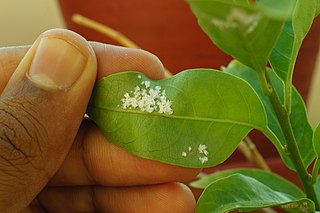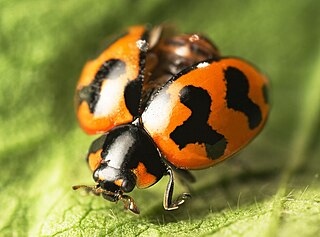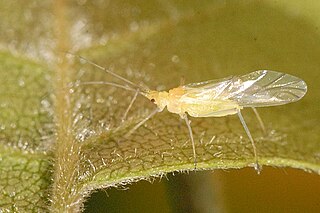
Hoverflies, sometimes called flower flies, or syrphid flies, make up the insect family Syrphidae. As their common name suggests, they are often seen hovering or nectaring at flowers; the adults of many species feed mainly on nectar and pollen, while the larvae (maggots) eat a wide range of foods. In some species, the larvae are saprotrophs, eating decaying plant and animal matter in the soil or in ponds and streams. In other species, the larvae are insectivores and prey on aphids, thrips, and other plant-sucking insects.

Woolly aphids are sucking insects that live on plant sap and produce a filamentous waxy white covering which resembles cotton or wool. The adults are winged and move to new locations where they lay egg masses. The nymphs often form large cottony masses on twigs, for protection from predators.

Asclepias syriaca, commonly called common milkweed, butterfly flower, silkweed, silky swallow-wort, and Virginia silkweed, is a species of flowering plant. It is in the genus Asclepias, the milkweeds. This species is native to southern Canada and of much of the conterminous eastern U.S., east of the Rocky Mountains, excluding the drier parts of the prairies. It grows in sandy soils and other kinds of soils in sunny areas. It was one of the earliest North American species described in Cornut's 1635 work Canadensium Plantarum Historia. The specific name was reused by Linnaeus due to Cornut's confusion with a species from Asia Minor.

Butterfly gardening is designed to create an environment that attracts butterflies, as well as certain moths. Butterfly gardening is often aimed at inviting those butterflies and moths to lay eggs as well. Because some plants are not fed upon by adult butterflies, the caterpillar host should also be planted for a bigger population of butterflies. Butterflies typically feed on the nectar of flowers, and there are hundreds of such plants that may be planted to attract them, depending on the location, time of year, and other factors. In addition to the planting of flowers that feed butterflies, other means of attracting them include constructing "butterfly houses", providing sand for puddling, water, and other resources or food items, including rotten fruit.

The Adelgidae are a small family of the Hemiptera closely related to the aphids, and often included in the Aphidoidea with the Phylloxeridae or placed within the superfamily Phylloxeroidea as a sister of the Aphidoidea within the infraorder Aphidomorpha. The family is composed of species associated with pine, spruce, or other conifers, known respectively as "pine aphids" or "spruce aphids". This family includes the former family Chermesidae, or "Chermidae", the name of which was declared invalid by the ICZN in 1955. There is still considerable debate as to the number of genera within the family, and the classification is still unstable and inconsistent among competing authors.

Intro

Rhopalosiphum is a genus of aphid of the family Aphididae that includes 16 species worldwide. Apart from sucking the phloem of host plants and thereby being treated in agriculture as pests, some species are vectors for viral pathogens.

Coccinella transversalis, commonly known as the transverse ladybird or transverse lady beetle is a species of ladybird beetle found from India across southern and southeastern Asia to Malesia and Australia. It is not to be confused with Coccinella transversoguttata, a widespread species in Europe and North America also known as the transverse ladybird. The alternative vernacular of small transverse ladybird may be used for C. transversalis in instances where these two species are discussed together.

The black bean aphid is a small black insect in the genus Aphis, with a broad, soft body, a member of the order Hemiptera. Other common names include blackfly, bean aphid, and beet leaf aphid. In the warmer months of the year, it is found in large numbers on the undersides of leaves and on the growing tips of host plants, including various agricultural crops and many wild and ornamental plants. Both winged and wingless forms exist, and at this time of year, they are all females. They suck sap from stems and leaves and cause distortion of the shoots, stunted plants, reduced yield, and spoiled crops. This aphid also acts as a vector for viruses that cause plant disease, and the honeydew it secretes may encourage the growth of sooty mould. It breeds profusely by live birth, but its numbers are kept in check, especially in the later part of the summer, by various predatory and parasitic insects. Ants feed on the honeydew it produces, and take active steps to remove the aphid's enemies. It is a widely distributed pest of agricultural crops and can be controlled by chemical or biological means. In the autumn, winged forms move to different host plants, where both males and females are produced. These mate and the females lay eggs which overwinter.

Phylloxeridae is a small family of plant-parasitic hemipterans closely related to aphids with only 75 described species. This group comprises two subfamilies and 11 genera with one that is fossil. The genus type is Phylloxera. The Phylloxeridae species are usually called Phylloxerans or Phylloxerids.

Calaphidinae is a subfamily of aphids in the family Aphididae. There are more than 60 genera and 360 described species in Calaphidinae.
Cinara confinis, the black stem aphid, is a species of aphid in the genus Cinara, found feeding on the twigs of various species of fir (Abies) and on several other species of coniferous trees. This aphid has a Holarctic distribution and is known from Europe, Asia, North America and Argentina.
The Buckthorn aphid or Buckthorn-potato aphid is an aphid in the superfamily Aphidoidea in the order Hemiptera. It is a true bug and sucks sap from plants. It is a cosmopolitan species.
The Chrysanthemum Aphid,, is an aphid in the superfamily Aphidoidea in the order Hemiptera. It is a true bug and sucks sap from plants.
Parasipyloidea zehntneri, is a species of phasmid or stick insect of the genus Parasipyloidea. It is found in Sri Lanka.

Hyperomyzus is a genus of aphids in the family Aphididae. There are at least 20 described species in Hyperomyzus.
Schouteden's sun snake is a species of snake in the subfamily Natricinae of the family Colubridae. The species, which is monotypic in the genus Helophis, is endemic to Central Africa.














